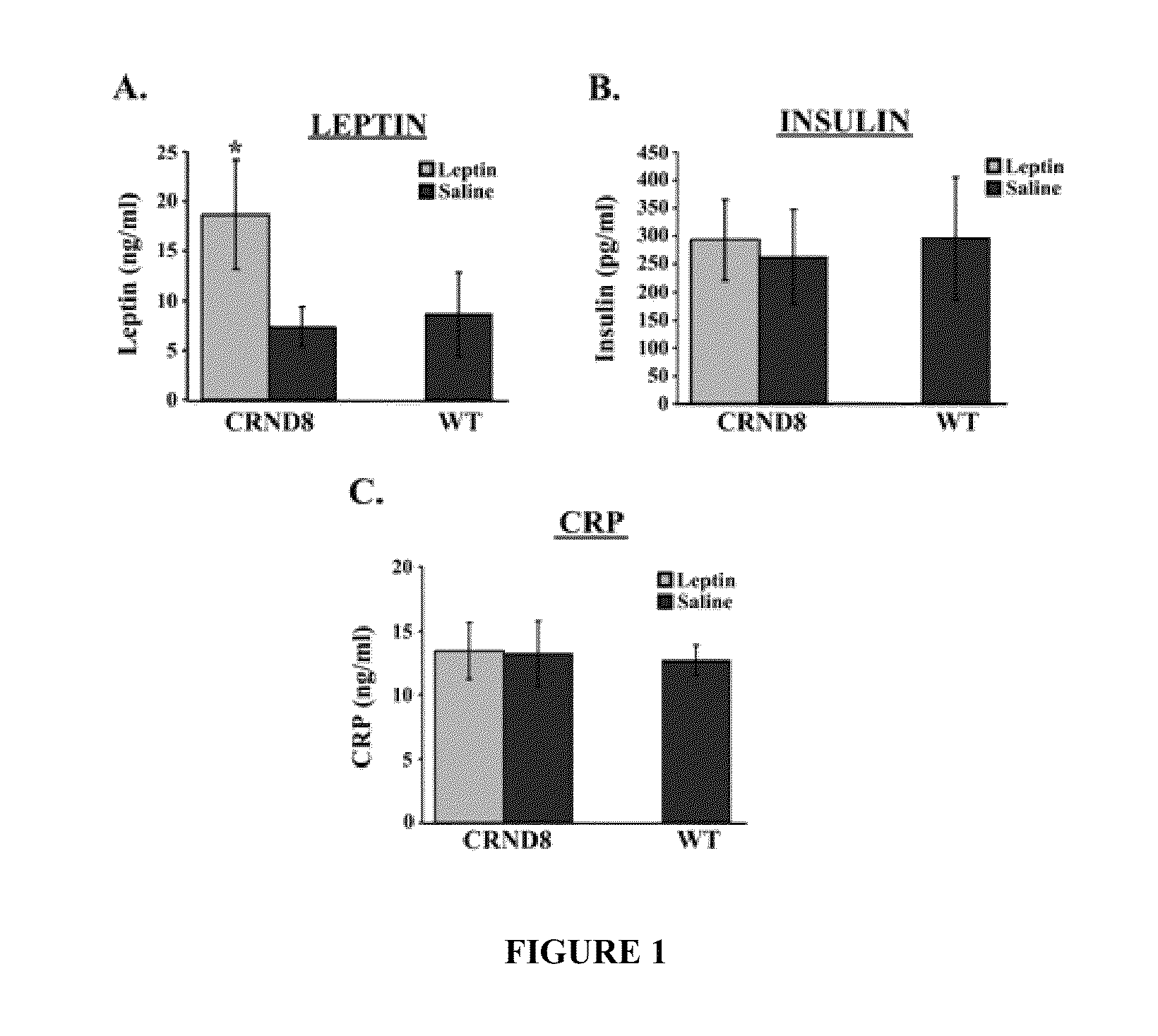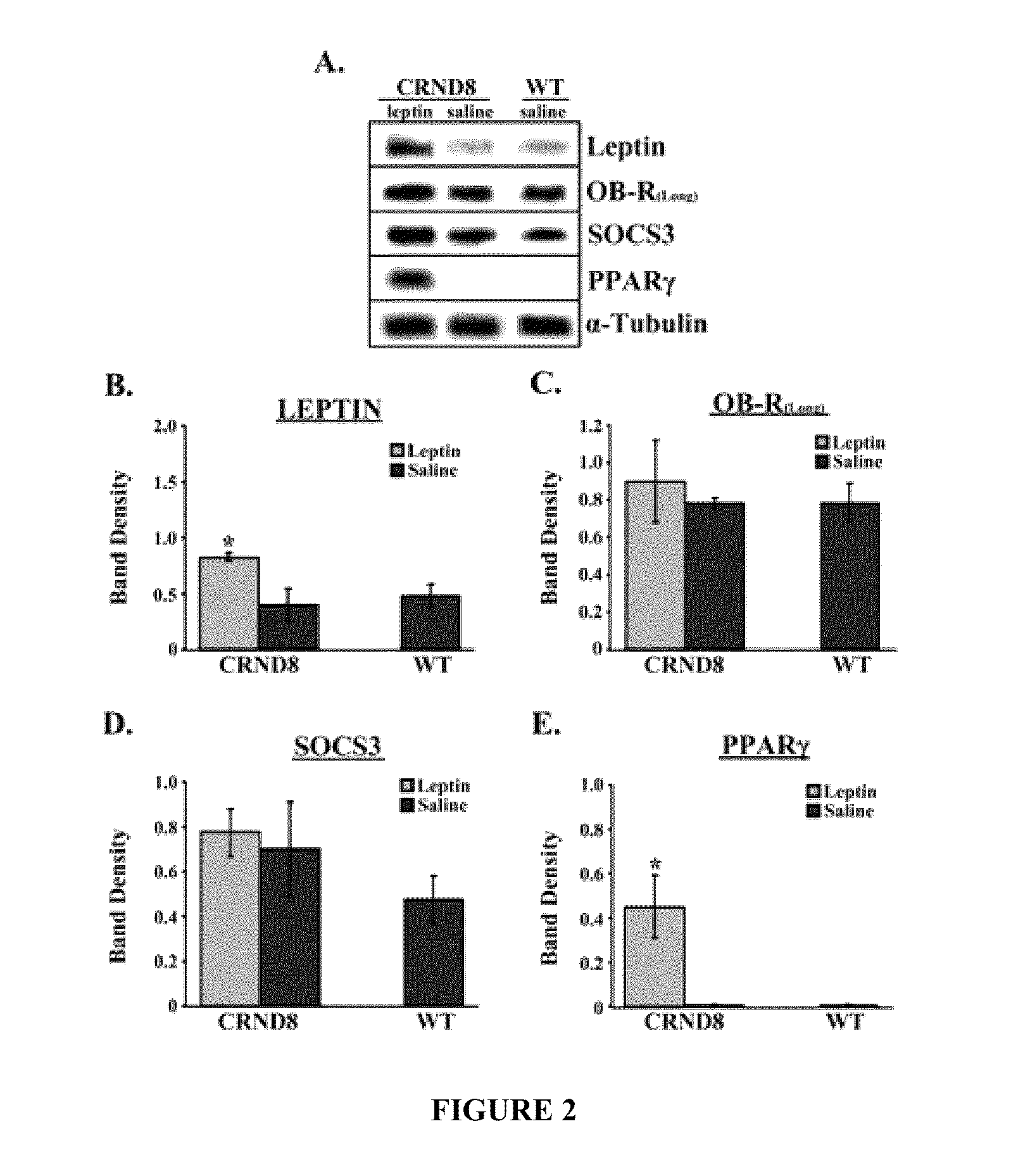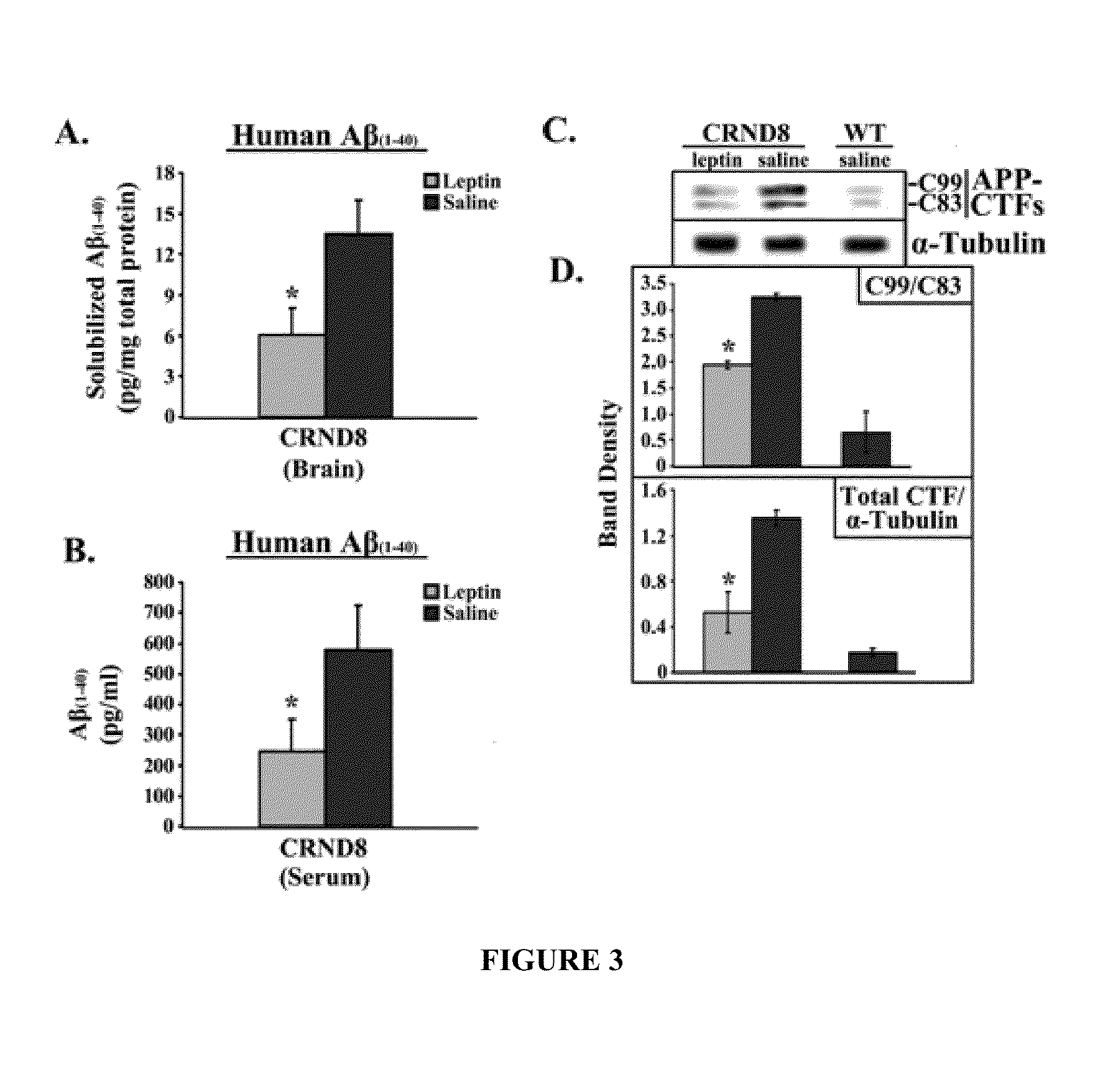Leptin compositions and methods for treating progressive cognitive function disorders resulting from accumulation of neurofibrillary tangles and amyloid beta
a neurofibrillary tangle and amyloid beta technology, applied in the field of compositions and methods for treating progressive cognitive function disorders resulting from accumulation of neurofibrillary tangles or amyloid beta, can solve the problems of clinical dementia, no condition characterized by widespread neocortical nfts lacks extensive neurodegeneration, and large atrophy of affected regions, so as to reduce or prevent progression, increase uptake of a, and reduce the effect o
- Summary
- Abstract
- Description
- Claims
- Application Information
AI Technical Summary
Benefits of technology
Problems solved by technology
Method used
Image
Examples
example 1
Effects of Chronic Leptin-Treatment on AD-Like Pathobiology and Cognitive Decline Using a Transgenic CRND8 Mouse Model System
[0406]1.1. Materials and Methods
[0407]1.1(a). Reagents and Antibodies
[0408]Alzheimer precursor protein (APP) 643-695 monoclonal antibody (mAb) was purchased from Millipore (Billerica, Mass.). Rabbit anti-PPARγ and —SOCS3, Tau (pSer396) mAb and tau (tau46) mAb were purchased from Cell Signaling. PHF-tau mAb (clone AT8) was purchased from Pierce Biotechnology (Rockford, Ill.). PHF-1 mAb was a gift from Dr. Peter Davies, Albert Einstein College of Medicine (Bronx, N.Y.). Rabbit anti-tau (pThr181) was purchased from Sigma-Aldrich. Rabbit anti-α-tubulin, -Leptin and -Leptin receptor (OB-R) were purchased from Affinity BioReagents (Golden, Colo.).
[0409]1.1(b). Animals and Housing CRND8 mice (n=22) carrying the APP695 gene with double mutations at KM670 / 671 / NL (Swedish mutation), along with V717F (Indiana mutation) on a C3H / He-057BL / 6 background and wild-type mice (n...
example 1.2
Effect of Leptin Administration on Insulin and Pro-inflammatory Proteins
[0435]The first set of studies examined the levels of leptin detectable in the serum of TgCRND8 mice. FIG. 1 shows bar graphs of serum concentrations (ng / ml) of leptin, insulin and CRP in CRND8 and wt mice assessed in serum from leptin- or saline-treated CRND8 or wt mice by ELISA. Leptin-treated transgenic animals showed significantly (p<0.05) elevated levels of leptin (FIG. 1A; left, light gray bar) compared to saline-treated animals (left, dark gray bar). The levels detectable in the saline-treated TgCRND8 were compatible to wild-type (wt) littermates (right bar). There was no significant difference in insulin levels observed in leptin- or saline-treated mice (FIG. 1B).
[0436]C-reactive protein (CRP), a protein whose levels rise dramatically during inflammatory processes occurring in the body, served as a biomarker for inflammation. There was no detectable difference in CRP levels observed in Leptin- or saline-...
example 1.3
Pathways Regulated by Leptin Administration in Brain
[0437]It generally is believed that the post-receptor binding of Leptin triggers the JAK / STAT pathway to induce gene transcriptional changes via activation of Janus tyrosine kinase 2 (JAK2), the signal transducer and activator 3 (STAT3), and the suppressor of cytokine signaling 3 (SOC3) in central and peripheral tissues. The levels of Leptin in the brains of Leptin-treated and saline-treated mice were investigated and the putative downstream effectors of Leptin, specifically SOCS3 and peroxisome proliferator-activated receptor-γ (PPARγ), were examined to determine whether they increased.
[0438]FIG. 2 shows an immunoblot showing leptin, OB-R(long), SOCS3, PPARγ and α-tubulin from brains from leptin-treated or saline-treated CRND8 or wild-type (wt) mice. Membranes were stripped and re-probed with α-tubulin antibody for normalization. Representative blots are shown (n=3). Normalized bands were analyzed by densitometry and are presented...
PUM
| Property | Measurement | Unit |
|---|---|---|
| body weight | aaaaa | aaaaa |
| body weight | aaaaa | aaaaa |
| body weight | aaaaa | aaaaa |
Abstract
Description
Claims
Application Information
 Login to View More
Login to View More - R&D
- Intellectual Property
- Life Sciences
- Materials
- Tech Scout
- Unparalleled Data Quality
- Higher Quality Content
- 60% Fewer Hallucinations
Browse by: Latest US Patents, China's latest patents, Technical Efficacy Thesaurus, Application Domain, Technology Topic, Popular Technical Reports.
© 2025 PatSnap. All rights reserved.Legal|Privacy policy|Modern Slavery Act Transparency Statement|Sitemap|About US| Contact US: help@patsnap.com



